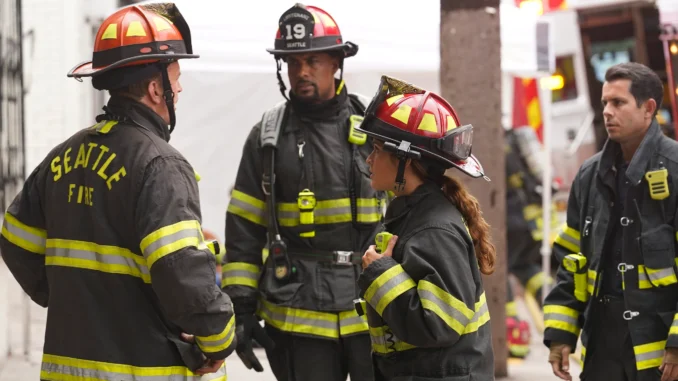
Native American culture and history run deep in Seattle, the city where Station 19 is set. Indeed, the very name Seattle is an homage to Chief Seattle, a great orator and leader of the Suquamish and Duwamish peoples known for making peace between American Indians and white settlers. Yet as impactful as Indigenous culture and history have been in Seattle, and Washington state as a whole (it’s home to more than 29 federally recognized tribal governments), that culture hasn’t been displayed much on the show or, for that matter, TV overall. Though Native and Indigenous representation is improving thanks to the success of shows like Reservation Dogs and the historic Oscar nomination of Native actor Lily Gladstone this year for Killers of the Flower Moon, there’s still a long way to go; only 1 percent of shows across all platforms feature an Indigenous person as a lead or recurring character, a 2023 study from the Native think tank Illuminative found.
That glaring absence of Indigenous representation is why “Give It All,” the seventh episode in Station 19’s truncated and sadly final season, is so impactful. The episode shows the 19 squad becoming acquainted with members of an Indigenous tribe, the Tulalip, a federally-recognized Native American tribe located on the Tulalip Reservation in the mid-Puget Sound area, and learning about their culture — specifically a ceremony that involves fire.
“We really wanted to look at how fire itself is sacred,” says Heidi-Marie Ferren, a Station 19 writer of Cherokee, Sioux, and Polish ancestry who penned the episode alongside Leah Gonzalez, a Mexican American writer who grew up in California’s Bay Area. Both got staffed on Station 19 after completing the prestigious Disney writing program, Ferren this season and Gonzalez in season five. “Fire isn’t necessarily something just to be managed. It is life, and we wanted to look at how an [Indigenous] station would approach a fire service a little differently than Station 19.”
Showrunners Zoanne Clack and Peter Paige and the whole Station 19 writers’ room had long wanted to feature Native stories on the show, according to Gonzalez, who’s been writing for the show for three seasons. “Every year, [Indigenous storylines] had been pitched,” Gonzalez says, “but we had no Native writers. And as a room, we felt like there should be a Native writer or multiple Native writers to pitch and ask questions so we could learn more together.” That hope was fulfilled when Ferren came on this season, and together Gonzalez and Ferren crafted “Give It All.”
The episode starts with the 19 crew responding to a call at a local park. When they arrive, though, Captain Andy Herrera (Jaina Lee Ortiz) and company are startled to find another, bigger issue at hand: a fire raging seemingly out of control. Unbeknownst to the Station 19 crew, they’d just arrived in the middle of a sacred prayer ceremony being performed by leaders of the Tulalip. Tensions flare right away as Herrera and her team demand that they extinguish the fire; the Tulalip counter that their controlled fire is not only under control but is also legally permitted and sanctioned — paving the way for a huge teachable moment for the crew, and us at home.
“The way we care for the land and those kinds of practices were abandoned for so long in this country,” Ferren says. For centuries, Indigenous tribes have used fire for myriad reasons, including communication with spirits in other realms and to gather and celebrate; it’s also used to clear areas for crops, for travel, and other purposes that are now understood to be beneficial and much more sophisticated than previously known by white society. “They know what they’re doing,” Ferren says.“The lesson that Andy learns is to be part of a community, to be part of a circle, rather than just at the top
Everyone on Station 19 took great care in making sure the tribe was depicted with respect. That translated to using Indigenous actors and not showing regalia on-screen that’s considered sacred; that’s also why the ceremony itself isn’t depicted but is merely seen in a reflection through Herrera’s point of view. Likewise, the Station 19 team ensured that the council member depicted in the episode was indeed from the Pacific Northwest. “It was a private social ceremony; we wanted to protect it,” says Gonzalez. “We didn’t want to re-create it.” Everyone, the writers say, was on board with the show’s intentions to respect the ceremony.
As the episode concludes, Herrera is gifted a Pendleton blanket, a symbolic gesture of respect that goes back generations. The moment was deeply moving for Ortiz and everyone involved in the episode. “The lesson that Andy learns is to be part of a community, to be part of a circle, rather than just at the top,” says Ferren. “She learns to ask for help and that being a good leader isn’t just about knowing what to do all of the time; it’s about allowing your community to support you. It’s a rebirth, which is something that the blanket symbolizes as well.”
Ortiz tells Shondaland she was deeply moved by the experience. “There aren’t enough of their voices [on-screen]. We need to continue to tell those stories. It really touched me.”
